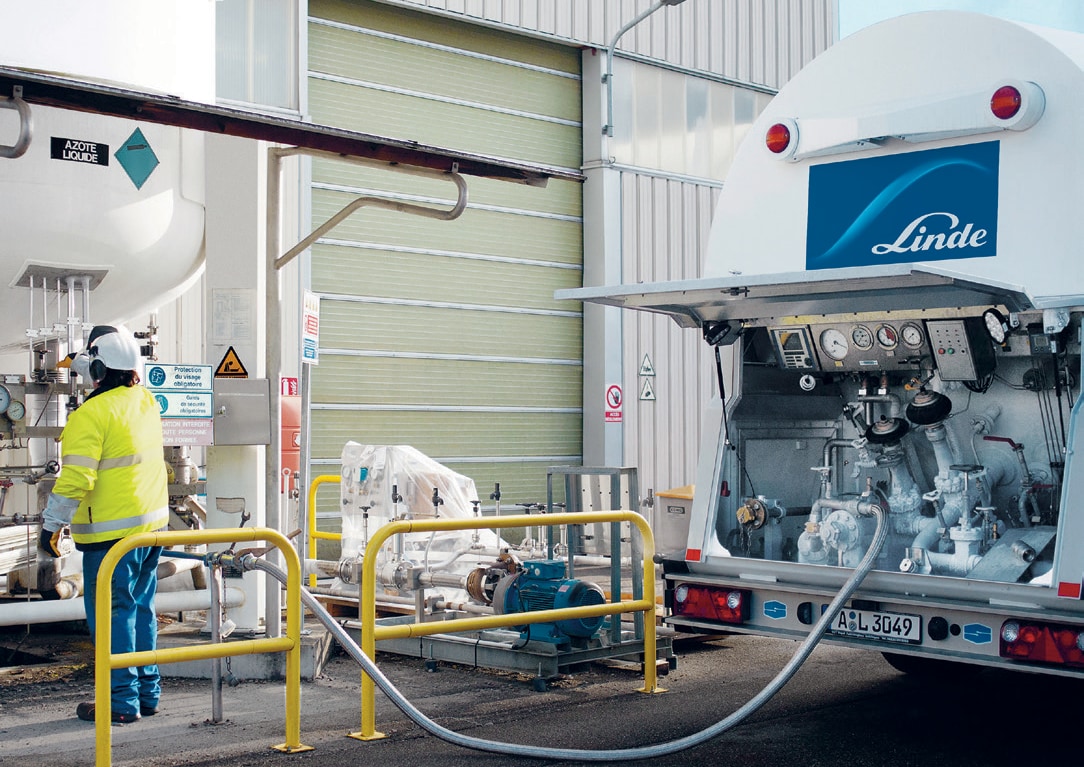
Using inert gases to prevent the oxidation
Oxidation is a chemical reaction where a substance, surface or product reacts with atmospheric oxygen in the
surrounding air. This can have many undesirable outcomes, including unwanted chemical reactions, the risk of
explosion, metal embrittlement and degradation of quality, especially in the case of foodstuffs.
The basic principle on inerting entails fully or partially replacing the air around or on top of a product with
a dry, inert gas. This forms a protective, safe layer of gas on the substance, preventing oxygen and/or moisture
from coming into contact with reactive or absorptive products. In addition, inerting can be used to dispel
flammable or poisonous gases. An inert atmosphere is particularly important when storing highly volatile
substances or products prone to oxidation.
An inert gas does not interact directly with a compound or product. Nitrogen is the most commonly used gas for
this purpose, but carbon dioxide or argon is sometimes used.
Many industrial processes rely on different inerting methods
There are many processes, where it is important to protect against unwelcome reactions, keep moisture away from sensitive substances, control critical reactions and ensure safety during maintenance work.In the food industry inerting is typically used to keep oxygen levels in and around food products low.
Aninert or modified atmosphere also stabilizes the product and increases shelf-life. Looking at the chemical industry, reactors, stirring tanks, centrifuges, vacuum filters, grinding and mixing plants, dryers and filling facilities are all often inerted.
Mines and silos also rely on inert gases for enhanced safety and fire protection. Many heat treatment furnaces purge flammables, oxygen and water from the furnace for safety reasons and to avoid oxidation of the part being treated. In a more general sense, inerting is also essential for purging pipes and vessels during maintenance and repair work on industrial plants.

Nitrogen is the gas most commonly used for inerting
Less frequently, carbon dioxide or – in exceptional cases – argon may also be used. Special industries or
applications rely on inerting mixtures. In welding shielding gas mixtures combine argon with hydrogen,
carbon dioxide, nitrogen and helium.
By comparison, modified atmospheres for food generally rely on gas
mixtures combining carbon dioxide, nitrogen and oxygen with other gases such as nitrous oxide, argon and
hydrogen.
Heat treatment furnaces typically deploy nitrogen, argon, hydrogen and other gases.
Find out more about the different inerting methods and their range of applications, in the inerting e-book.
Inerting areas
Oxidation is a chemical reaction in which atmospheric oxygen in the air surrounding food and drinks attacks the product. This can occur at or below ambient temperatures (i.e. during normal storage of beverages, oils, fruit & vegetables or finished food products). It can also happen at elevated temperatures, such as during processing or deep-fat frying. We deliver food-grade nitrogen and other inert gases that prevent or minimize the effects of oxidation. For example, nitrogen is used to keep oxygen levels in and around the product low. An inert atmosphere stabilizes the product and increases its shelf life. The air in the cavity or headspace around a product can contain moisture and oxygen. High-purity nitrogen is completely dry and inert, preventing it from reacting with the product when used to replace the air in packaging. This is a safe and reliable way of protecting food from the effects of oxidation. We also deliver high-precision valve control systems for filling or emptying food tanks or containers. These valves maintain a constant protective blanket by automatically adjusting the nitrogen content.
When storing highly volatile substances or substances prone to oxidation, safety and product preservation are of paramount importance. Blanketing with nitrogen is a safe and dependable method for constantly maintaining a protective layer of gas on top of the substance. Humid air in the head space is replaced by high purity, inert and totally dry nitrogen. A precise valve control system ensures that as the tank is filled or emptied, the nitrogen content is automatically compensated to maintain the protective blanket. The result is safety, reliability and protection from degradation through oxidation. For vessels often used in batch processes, characterized by cyclic filling and emptying, we have developed special inert gas sluices which prevent the entry of oxygen effectively.
Fluffing is a process widely used by manufacturers in the fats and mayonnaise industry. This technique involves
using nitrogen to change the texture of the product. Mainly applied to fats in bakery products, fluffing ensures
the desired density and eliminates any air.
To protect oil and improve oil stability, oxygen should never come
into contact with the product during the production process. In line with the worldwide trend towards replacing
harsh physical/chemical preservative methods with gentler alternatives, the food industry is increasingly relying
on nitrogen to meet the oxidation challenge.
Oxidation is a chemical reaction, in which atmospheric oxygen in the air surrounding food and drinks attacks the product. This can happen at or below ambient temperatures (i.e. during normal storage of beverages, oils, fruit & vegetables or finished food products). It can also occur at elevated temperatures, such as during processing or deep-fat frying. Through purging, a gas such as nitrogen, carbon dioxide or argon is added to or bubbled through a food or beverage. This displaces atmospheric gases, replacing them with an inert atmosphere. Undesirable substances are eliminated, inhibiting and reducing unwanted chemical reactions with oxygen. As a result, food quality is preserved. We deliver food-grade nitrogen and other inert gases that prevent or minimize the effects of oxidation. For example, nitrogen is used to keep the oxygen levels in and around the product low. An inert atmosphere stabilizes the product and increases its shelf life.
The atmosphere within process areas, for example in reactors, can be efficiently and cost-effectively purged of oxygen and moisture at start-up or shut-down with nitrogen (GAN). Filling and rinsing the processor with the dry gas is fully controllable. No pumps are needed so the risk of sparks and ignition or cross contamination is eliminated. What's more, the use of nitrogen ensures 'no reaction' either with the substance previously stored or with what is still to come.
We deliver food-grade nitrogen and other inert gases that prevent or minimize the effects of oxidation. For example, nitrogen levels can be used to keep oxygen levels in and around the product low. An inert atmosphere stabilizes the product and lengthens its shelf life. Through sparging, a gas such as nitrogen, carbon dioxide or argon is added to or bubbled through a food or beverage. This displaces atmospheric gases, replacing them with an inert atmosphere. Undesirable substances are eliminated, inhibiting and reducing unwanted chemical reactions with oxygen. As a result, food quality is preserved.
In order to protect the oil and improve oil stability, oxygen should never come in contact with the product at any stage of the production process. In line with the worldwide trend towards the replacement of harsh physical/chemical preservative methods with less severe alternatives, the food industry is increasingly relying on nitrogen to resolve the oxidation challenge. Sparging is the process of adding gas as fine bubbles to a process liquid in order to boost the chemical or biological reaction by increasing the available surface area between the two phases. Sparging is fast, effective and can be flexibly introduced to the process environment. Sparging is applied to remove oxygen from a product. Nitrogen is a chemical element. Because it is an inert gas, it does not interact directly with the product. It is used to displace atmospheric air (and thus oxygen) and water vapour to avoid oxidation. Sparging involves injecting a gas into a liquid.
Nitrogen gas provides a flexible tool for mixing and storing liquids. It offers considerable advantages over conventional stirring methods. No mechanical devices are needed, so there is no reaction with the liquid and no subsequent cleaning is necessary. The method is readily controllable and offers the added advantage that it introduces no new oxygen into the system while at the same time reducing the oxygen content.
Stripping is the process of adding gas as fine bubbles to a process liquid in order to absorb a component from the liquid. Nitrogen is used in stripping applications such as removing oxygen from oil or waste water to promote anaerobic activity. This method affords excellent control and does not introduce any other substance into the liquid.
- Blanketing for the food industry
- Blanketing for chemical industry
- Fluffing
- Purging for the food industry
- Purging for chemical industry
- Sparging for food industry
- Sparging for chemical industry
- Stirring
- Stripping
Blanketing for the food industry – raising product quality and safety standards
Oxidation is a chemical reaction in which atmospheric oxygen in the air surrounding food and drinks
attacks the product. This can occur at or below ambient temperatures (i.e. during normal storage of
beverages, oils, fruit & vegetables or finished food products). It can also happen at elevated
temperatures, such as during processing or deep-fat frying.
We deliver food-grade nitrogen and other inert gases that prevent or minimize the effects of oxidation.
For example, nitrogen is used to keep oxygen levels in and around the product low. An inert atmosphere
stabilizes the product and increases its shelf life.
The air in the cavity or headspace around a product can contain moisture and oxygen. High-purity
nitrogen is completely dry and inert, preventing it from reacting with the product when used to replace
the air in packaging. This is a safe and reliable way of protecting food from the effects of oxidation.
We also deliver high-precision valve control systems for filling or emptying food tanks or containers.
These valves maintain a constant protective blanket by automatically adjusting the nitrogen content.

With Linde Linde Nitrogen Services you can optimize your gas supply
Every company must periodically perform varying extents of maintenance. Although this is often planned,
there are unfortunate
occasional urgent situations.
We would be pleased to work with you on an action plan that enables you to quickly get back online without
sacrificing any quality or safety.
- ● Purging with nitrogen
- ● Inerting with nitrogen
- ● Drying with nitrogen
- ● Blanketing with nitrogen
- ● Pressure testing with nitrogen
- ● Network buffering with nitrogen
 Downloads
Downloads
| Safety datasheets | Product datasheets & brochures |
|---|---|

